Instructions on how to propagate begonia at home for novice florists
Florists love begonias for their luxurious appearance and relative unpretentiousness. There are over 1000 species of decorative leafy and flowering begonias in the world. In indoor floriculture, the following are common: Mason, Elatior (flowering), royal, ever-flowering, as well as other varieties of blooming and decorative leafy home beauty. How to propagate begonia at home, which methods are the most rational and provide 100% plant survival.
Begonia breeding methods
The huge variety of species and varieties implies the application of a specific breeding method to each of them. Begonias are propagated by seeds, cuttings, dividing the tuber and bush, leaf plates.
There are several ways to flowering flowers. They can reproduce by cuttings, by dividing the tuber. Decorative-leaved varieties reproduce by a leaf plate, a leaf with a petiole, dividing a bush, and seeds. Eternal begonia propagates by seeds, cuttings.
Seed propagation is quite difficult and tedious. On sale you can often find seeds of tuberous begonias. If there is no experience and there are no suitable conditions, it is not worth buying such planting material. Without creating a special microclimate and without maintaining the temperature and lighting, it will be impossible not only to grow a plant, but also to wait for the emergence of seedlings.
Seeds are the easiest to reproduce ever-flowering begonia... Ornamental-leaved with seed propagation do not repeat the characteristics of the parent plant, it is better to propagate them by a leaf.
Preparatory care
In order to cut a certain amount of propagation material from the mother bush, it is necessary to provide the plant with proper care. During the growing season, prolonged overdrying of the earthen coma should not be allowed, alternating feeding with organic and mineral fertilizers.
How to propagate correctly
A certain method of reproduction is applicable to different species and varieties, therefore the result depends on its choice.
Cuttings
Cuttings can only be cut from stemmed begonias. This is the ever-flowering begonia and Elatior. The first takes root very quickly, the second with difficulty. Cutting flowering species helps to maintain the characteristics of the mother plant. You can propagate in autumn or spring. When propagating tuberous begonias, it is recommended to separate the cuttings directly from the tuber itself.
When sprouting tubers in spring, it is necessary to separate several cuttings, which have reached a height of 12 cm. The slices should be powdered with charcoal and put on the table to dry. After a few hours, you can plant the cuttings in the ground.
Attention! Cuttings root better in the ground; when rooting in water, there is a high probability of rotting of the cut and the death of the plantAll about growing room begoniasdairy material.
After planting in the soil, it is recommended to make a mini-greenhouse to speed up the rooting process. A month later, at the end of the cutting, you will notice the appearance of roots, the plant can be transplanted into another container.
The mother bush from which it is planned to take planting material must be placed in a cool place since autumn so that the tuber has a rest for 3 months.
The tuber is planted in January. After the stalk has built up a green mass, it is necessary to cut under the 2 upper leaves, leaving a stalk with one leaf on the tuber - it will give the stalk again, which can also be separated for reproduction. When propagated by cuttings, flowering will occur in August.
Autumn reproduction is similar to spring reproduction. Only tuber germination is not required. In August, you should dig out the tuber and separate the cuttings from it, each of which is planted in a separate glass, deepening the cut 4 cm deep. After rooting, care for the cuttings is the same as for adult plants.
Leaves
Ornamental-leaved varieties reproduce with leaf plates. Each leaflet has a thick longitudinal vein on the inside, from which roots subsequently appear.
The leaf chosen for propagation must be large and healthy. When dividing into small fragments, you need to look to ensure that a part of this vein is present on each of them.
To plant the cut pieces, you need to prepare an air-permeable soil consisting of an equal amount of peat and perlite. You can plant in 2 ways: either bury the fragments vertically, or put them horizontally on the ground surface. It must be remembered that the thickened vein must be in contact with the ground, otherwise the leaf will not take root.
Which begonias are suitable for leaf plate propagation, because not every species and variety is suitable for such propagation.
Features:
- it is necessary to choose plants with a dense leaf, the back of the leaf plate should have noticeable pubescence;
- some varieties of ampelous begonias with hanging shoots are also capable of propagating with a leaf plate;
- when multiplying decorative leaf begonia from one large leaf, you can get a large number of young plants;
- a leaf stalk can be placed in water, and wait for it to start up roots, you can plant it immediately in the ground, or you can divide it into many fragments and root each of them separately.
Many are afraid to cut the leaf into pieces, especially when there is very little planting material. It is important to have experience when propagating in parts of a leaf.
First, you need to practice on unpretentious varieties and on those that you will not mind losing, that is, there is an opportunity to cut off some of the leaves from the mother plant and try to root them. Many growers use the partial leaf propagation method when growing begonias commercially.
You can root it in another way. Take a whole sheet, turn it over with its back to you and make transverse cuts with a sharp blade or knife. Then lay the sheet of holes horizontally on the surface of the ground, pin it to the ground so that it does not bristle.
Leaf propagation - nuances
- Rooting should take place in a mini-greenhouse, high humidity and temperature will contribute to the early appearance of roots.
- The container with leaf fragments should stand on a light windowsill, but without direct sunlight, otherwise the fragments will pair.
- Every day you need to ventilate the greenhouse, moisten the soil as needed.
- A transplant should be carried out only after the plants are strong, otherwise it will be difficult for them to adapt to new conditions.
On a note! The ideal rooting method is to place the leaf fragments in a Zip bag. Moistening is carried out only once, before planting, the bag is not opened for airing, only before the young seedlings are planted.
Seeds
A way that requires labor and constant attention. Suitable for experienced florists. The seeds are very small, therefore, before sowing, they must be mixed with dry river sand, and then evenly scattered over the surface.
When planting pelleted seeds, it is not recommended to bury them in the ground. Keeping the soil moist is the key to successful germination.If you do not keep track and let the soil dry out, the coated seeds will dry out, and it will be impossible to wake them up.
It is better to start sowing in January. Young plants need additional lighting with fluorescent lamps. With proper care, young begonias will have time to get stronger by the cold season.
After sowing, create a mini-greenhouse, put the container in a bright place, ventilate and moisten the soil as needed.
The first shoots appear 2 weeks after sowing. For young seedlings, it is important to change the conditions: you need to lower the temperature. After 2 true leaves appear on the plant, the seedlings dive into separate cups.
By dividing the tuber
The most effective way to propagate tuberous begonias. It is possible to divide the tuber of the mother plant only if the adult specimen is at least 3 years old and each has 3-5 healthy buds.
The division of the tuber is carried out in early spring, as soon as the buds begin to hatch. When the shoots grow back, it is no longer worth disturbing the mother plant, since you can lose all the planting material.
When dividing a tuber, it is important to take into account that there should be at least 1 kidney on each cut. Cut with a sharp knife. Places of cuts should be sprinkled with charcoal. Such treatment will allow superficial wounds to heal faster.
Parts of the tuber are seated in separate cups, covered with a part of a plastic bottle.
Attention! When planting, only the lower half of the tuber is deepened, the upper one remains on the surface!
After the leaves appear, the shelter must be removed, and when the sprouts reach 7 cm in height, the upper part of the tuber will need to be sprinkled with soil.
By dividing the bush
An adult plant propagates in this way. In order to get new specimens, begonias should be removed from the pot, shaken off the ground as much as possible, and old foliage and stems removed. When dividing, it is important to look at each division to have roots and growth points. After all the manipulations, new plants are planted in separate containers and sent to a light windowsill for growing.
How to look after further
Reproduction was successful, the planting material gave many new babies and independent plants, now it is important to properly care for the babies in order to avoid the loss of the variety you like.
- Begonia prefers a well-lit place, but the flowerpot should not be placed on the southern windowsill.
- The plant is thermophilic and does not tolerate sudden changes in temperature.
- Responds well to feeding. With timely fertilization, it is covered with a cap of flowers.
If you follow the recommendations, you can enjoy beautiful flowering and decorative-leaved varieties.
What to do, if
When growing begonias, you can often face some problems.
If roots do not appear
It is possible that the wrong propagation method was chosen for rooting a certain variety. Cuttings appear for a long time in an unsuitable substrate for them: if the soil is very heavy. To speed up the appearance of roots, you can remove the cutting and transplant it into more nutritious and loose soil.
If not a young plant does not develop
Begonia may not develop for several reasons:
- if the tuber of the plant is deeply buried in the soil;
- if the begonia was attacked by pests;
- too poor soil;
- lack of sufficient lighting and feeding.
If all the reasons are eliminated, you can achieve good growth and development of a flowering or decorative leaf begonias, and admire the gorgeous flowers or painted leaves of an exotic beauty.
When caring for begonia, it is important not to overmoisten the soil, otherwise the plants can get sick. To control the situation, it is important to plant the plants in wide pots filled with fertile, breathable soil. In response to proper care and attention, the plant will delight you with good growth.
Watch a video about the propagation of begonias by leaves and cuttings:




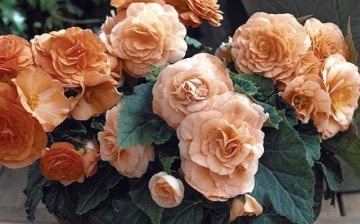
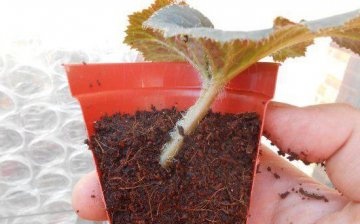



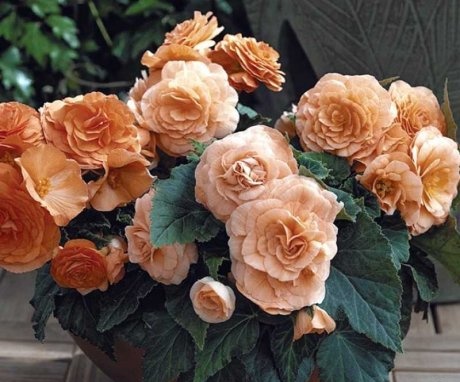
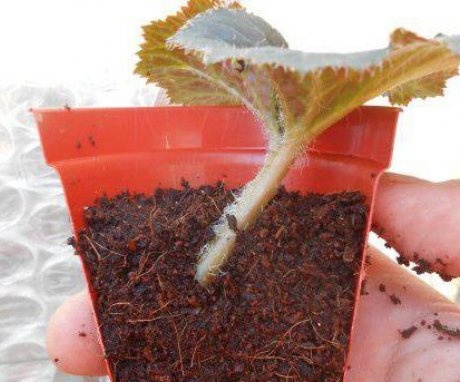
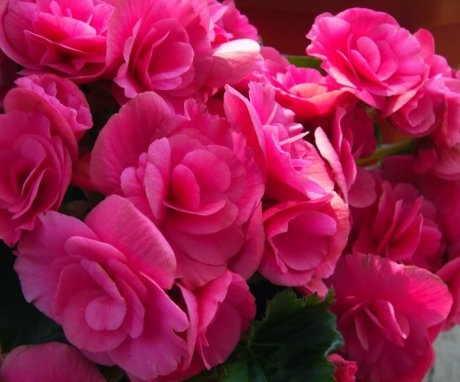
Begonia is a beautiful flower and I have already thought about propagating it. The best, in my opinion, will be planting cuttings, they take root well and you can quickly form a small begonia bush.